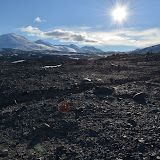 |
| Antarctica 2012-2013 field trip to F6 |
The field season is now well underway for Kevin and me. Our first week at McMurdo station was spent in orientations and meetings ranging in topics from how to survive in a sudden blizzard to where to find gloves for cleaning the lab to planning helicopter transportation to and from field sites.
We spent about a week in Taylor Valley at a field camp called F6 on the shores of Lake Fryxell. The trip started out with a helicopter ride from McMurdo station to the field camp in the Dry Valleys. This is a 30 minute trip by helicopter, or a 70 mile treacherous journey by foot over the sea ice... which we never do. We always take a helicopter. Once in Taylor Valley, our mission was to hike to streams and find cyanobacteria mats, and collect soil samples for a student's project back at Virginia Tech. Pictures from our trip to the field are in the photo album (linked above). We saw some interesting things, including a mummified seal near one of our study sites!
As is common in Antarctica, the weather did not really cooperate with us. We needed the melt-water streams to be flowing for some of the work we had to do. Instead, the valleys were cold, overcast, and snowy for much of the time we were there. Thus, there was very little met-water flowing through the streams. Also, we found a recently lost and headless juvenile penguin on the lake ice on Lake Fryxell while we were travelling back from one of our field sites. It is not uncommon for penguins or seals to get lost and wander up into the Dry Valleys from the sea ice. Skuas (giant gulls adapted to cold climates) will scavenge or kill the weakened animals and take what they can. There are quite a few seal carcasses that have been mummified by the cold and dry climate in the Dry Valleys. Some of these seals are hundreds of years old.
A snow storm hit Taylor Valley on the day we were scheduled to return, two days before Christmas. The helicopters don't fly when the weather is bad, and thus we were stranded in Taylor Valley until after Christmas. We hiked from F6 camp to Lake Hoare camp, where some other Dry Valley researchers had gathered for Christmas. The hike over Canada Glacier is well marked and usually uneventful. However, we were hiking because the helicopters weren't flying on account of the bad weather. Consequently, our hike was a little nerve-wracking because we were trying to beat out the on-coming snow storm. We ended up seeing about 4-6" of snow, which is rare for the Dry Valleys since it's a desert with very little precipitation. Being on top of a glacier with the big fat snowflakes surrounding us was peaceful, but it's always a little scary when you don't know how much is going to accumulate or now bad visibility is going to get. Needless to say, we made it to the camp just fine.
We celebrated Christmas at Lake Hoare with about 10 other people. We made a very elaborate gingerbread house. Maybe some pictures of that will come later.
We are now back at McMurdo. We will be doing some day trips to work on some long term soil ecology experiments. I'll post more about that later.


